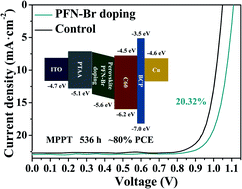当前位置:
X-MOL 学术
›
J. Mater. Chem. A
›
论文详情
Our official English website, www.x-mol.net, welcomes your
feedback! (Note: you will need to create a separate account there.)
Reducing photovoltage loss at the anode contact of methylammonium-free inverted perovskite solar cells by conjugated polyelectrolyte doping
Journal of Materials Chemistry A ( IF 10.7 ) Pub Date : 2020/03/14 , DOI: 10.1039/d0ta00892c He Wang 1, 2, 3, 4, 5 , Yilong Song 1, 2, 3, 4, 5 , Yifei Kang 1, 2, 3, 4, 5 , Song Dang 1, 2, 3, 4, 5 , Jing Feng 3, 4, 5, 6, 7 , Qingfeng Dong 1, 2, 3, 4, 5
Journal of Materials Chemistry A ( IF 10.7 ) Pub Date : 2020/03/14 , DOI: 10.1039/d0ta00892c He Wang 1, 2, 3, 4, 5 , Yilong Song 1, 2, 3, 4, 5 , Yifei Kang 1, 2, 3, 4, 5 , Song Dang 1, 2, 3, 4, 5 , Jing Feng 3, 4, 5, 6, 7 , Qingfeng Dong 1, 2, 3, 4, 5
Affiliation

|
The efficiency of perovskite solar cells (PSCs) has developed rapidly in recent years, but the stability has still lagged behind. The ion migration effect, especially from small methylammonium (MA) cations, is a main factor for stability issues, and the use of MA-free perovskites is one potential pathway to suppress ion migration. In this work, we reveal that there is a much lower valence band maximum (VBM) of −5.8 eV for the most studied MA-free perovskite FA0.83Cs0.17PbI2.7Br0.3, which is much different from that of traditional perovskites, and the huge energy level mismatch between perovskites and the hole transport layer (HTL) is a major factor in limiting the device performance of MA-free PSCs. It was found that doping the conjugated polyelectrolyte poly[(9,9-bis(3′-((N,N-dimethyl)-N-ethylammonium)-propyl)-2,7-fluorene)-alt-2,7-(9,9-dioctylfluorene)] (PFN-Br) into the perovskite can significantly promote anode contact and result in better device performance as well as stability of FA0.83Cs0.17PbI2.7Br0.3 based MA-free PSCs in an inverted planar structure. PFN-Br increases the energy position of the VBM of perovskites and results in well-matched energy levels between the perovskite and HTL of poly[bis(4-phenyl) (2,4,6-trimethylphenyl) amine (PTAA). Carrier extraction and transportation are highly encouraged at the surface of PTAA/perovskite, and corresponding interface recombination is effectively suppressed. As a result, a 60 mV increase in VOC is achieved, and this promotes an excellent device efficiency of 20.32%. At the same time, the efficient device displays significant stability under continuous illumination and bias under MPP conditions, and could maintain 80% of its initial power conversion efficiency (PCE) under continuous operation under one sun illumination over 500 hours.
中文翻译:

通过共轭聚电解质掺杂降低无甲基铵态钙钛矿型太阳能电池阳极触点的光电压损耗
钙钛矿太阳能电池(PSC)的效率近年来发展迅速,但稳定性仍然落后。离子迁移效应,特别是来自小甲基铵(MA)阳离子的迁移效应是稳定性问题的主要因素,而不含MA的钙钛矿的使用是抑制离子迁移的一种潜在途径。在这项工作中,我们揭示了,对于研究最多的无MA钙钛矿FA 0.83 Cs 0.17 PbI 2.7 Br 0.3的-5.8 eV的价带最大值(VBM)更低。与传统的钙钛矿有很大的不同,钙钛矿和空穴传输层(HTL)之间的巨大能级失配是限制无MA的PSC器件性能的主要因素。结果发现,掺杂共轭聚电解质聚[(9,9-双(3' - ((Ñ,Ñ二甲基) - ñ -ethylammonium) -丙基)-2,7-芴) - ALT -2,7- (9,9-二辛基芴)](PFN-Br)进入钙钛矿可以显着促进阳极接触,并带来更好的器件性能以及FA 0.83 Cs 0.17 PbI 2.7 Br 0.3的稳定性倒置平面结构中的无MA的PSC。PFN-Br会增加钙钛矿的VBM的能量位置,并导致钙钛矿和聚[双(4-苯基)(2,4,6-三甲基苯基)胺(PTAA)的HTL之间的能量水平完全匹配。高度鼓励在PTAA /钙钛矿的表面进行载流子的提取和运输,并有效地抑制了相应的界面复合。结果,实现了V OC的60 mV的增加,从而提高了20.32%的出色器件效率。同时,该高效器件在连续照明和MPP条件下的偏压下表现出显着的稳定性,并且在500个小时的太阳光照下连续运行下,可以保持其初始功率转换效率(PCE)的80%。
更新日期:2020-04-15
中文翻译:

通过共轭聚电解质掺杂降低无甲基铵态钙钛矿型太阳能电池阳极触点的光电压损耗
钙钛矿太阳能电池(PSC)的效率近年来发展迅速,但稳定性仍然落后。离子迁移效应,特别是来自小甲基铵(MA)阳离子的迁移效应是稳定性问题的主要因素,而不含MA的钙钛矿的使用是抑制离子迁移的一种潜在途径。在这项工作中,我们揭示了,对于研究最多的无MA钙钛矿FA 0.83 Cs 0.17 PbI 2.7 Br 0.3的-5.8 eV的价带最大值(VBM)更低。与传统的钙钛矿有很大的不同,钙钛矿和空穴传输层(HTL)之间的巨大能级失配是限制无MA的PSC器件性能的主要因素。结果发现,掺杂共轭聚电解质聚[(9,9-双(3' - ((Ñ,Ñ二甲基) - ñ -ethylammonium) -丙基)-2,7-芴) - ALT -2,7- (9,9-二辛基芴)](PFN-Br)进入钙钛矿可以显着促进阳极接触,并带来更好的器件性能以及FA 0.83 Cs 0.17 PbI 2.7 Br 0.3的稳定性倒置平面结构中的无MA的PSC。PFN-Br会增加钙钛矿的VBM的能量位置,并导致钙钛矿和聚[双(4-苯基)(2,4,6-三甲基苯基)胺(PTAA)的HTL之间的能量水平完全匹配。高度鼓励在PTAA /钙钛矿的表面进行载流子的提取和运输,并有效地抑制了相应的界面复合。结果,实现了V OC的60 mV的增加,从而提高了20.32%的出色器件效率。同时,该高效器件在连续照明和MPP条件下的偏压下表现出显着的稳定性,并且在500个小时的太阳光照下连续运行下,可以保持其初始功率转换效率(PCE)的80%。











































 京公网安备 11010802027423号
京公网安备 11010802027423号